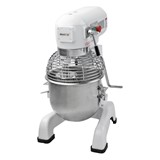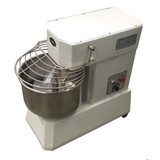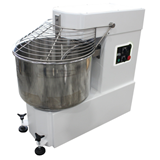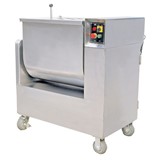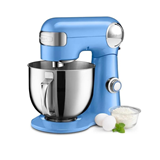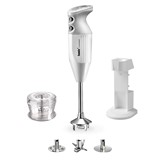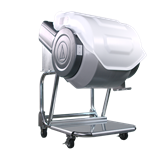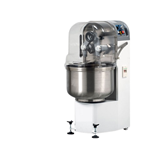Discover industrial planetary mixer prices in Australia, with costs from $4,000 to $25,000. Learn about mixer types, maintenance, financing, warranties, and compliance tips in this expert buying guide.
Key takeaways
- Prices: Industrial planetary mixers in Australia typically cost between $4,000 and $25,000, depending on size, capacity, and automation features.
- Types: Floor-standing mixers (60–200L) are common in commercial bakeries and food production, while table-top mixers (10–40L) suit smaller operations.
- Financing: Equipment loans and lease options are available from 5.95% p.a. interest, often requiring only 2–3 years of trading history.
- Maintenance: Routine maintenance every 500–800 hours of use prevents motor and gear failure.
- Compliance: Machines must meet Australian safety standards AS/NZS 4024.1 and include CE marking and food-grade contact materials.
- Key considerations: Buy for capacity, build quality, control settings, ease of cleaning, and access to spare parts.
- Warranties: Most machines come with 12–24 months standard warranty; extended warranties may be available for commercial kitchens.
Introduction
Whether you're running a commercial bakery, food manufacturing plant, or large-scale catering operation, an industrial planetary mixer is essential for achieving high-volume, consistent mixing. But choosing the right model, understanding the price range, and navigating compliance requirements in Australia can be complex.
This guide will walk you through the entire buying journey—covering machine types, features, pricing, financing, maintenance, and Australian standards—so you can make an informed and confident purchase.
Types of industrial planetary mixers
There are three main types of industrial planetary mixers used across food processing, pharmaceuticals, and cosmetics sectors:
1. Table-top planetary mixers (10–40L)
Ideal for small to mid-sized kitchens, R&D labs, or small-batch production.
- Capacity: 10–40 litres
- Price range: $4,000–$7,000
- Suitable for: bakeries, small restaurants, testing facilities
2. Floor-standing planetary mixers (60–200L)
Designed for high-capacity mixing in commercial kitchens or industrial food production.
- Capacity: 60–200 litres
- Price range: $8,000–$25,000
- Suitable for: industrial bakeries, ready-meal manufacturers, catering services
3. Custom-configured or automated planetary mixers
Incorporate programmable logic controllers (PLCs), automatic bowl lifts, or ingredient feeders.
- Custom pricing: $20,000+, depending on add-ons
- Suitable for: highly automated food and cosmetics production lines
Industrial planetary mixer prices in Australia
Here’s a breakdown of indicative pricing by capacity and configuration:
- 10–20L table-top mixers typically range from $4,000 to $6,000, making them a cost-effective choice for small-scale food production or test kitchens.
- 30–40L table-top mixers are priced between $6,000 and $7,500, suitable for mid-sized bakeries or restaurants needing slightly higher batch capacities.
- 60–80L floor-standing mixers generally cost $8,000 to $11,000, offering the power and size needed for consistent, high-volume mixing in commercial kitchens.
- 100–200L floor-standing mixers fall into the $12,000 to $25,000 price bracket, ideal for industrial-scale bakeries and food manufacturers.
- Custom-configured or PLC-enabled planetary mixers above 200L start from $25,000 and can exceed $45,000, depending on automation features and integration with production lines.
Note: All prices are in Australian dollars and exclude GST and installation fees. Always confirm final costs with your supplier, including delivery and any optional extras such as extended warranties or compliance certification.
Key features to consider
When comparing industrial planetary mixers, consider:
- Bowl capacity: Match volume to production needs.
- Motor power: Higher wattage = better performance for dense doughs.
- Speed settings: Variable controls for whipping, blending, and kneading.
- Build quality: Stainless steel bowls and frames offer longer durability.
- Bowl-lift mechanism: Hydraulic vs. manual options.
- Safety guards and emergency stop: Must comply with Australian WHS.
- Cleaning access: Detachable parts for fast sanitisation.
Operation and maintenance
Operation best practices
- Ensure stable power supply to avoid motor surges.
- Don’t overload the bowl capacity—this reduces gearbox life.
- Train staff on safe start/stop procedures.
Maintenance tips
- Daily: Clean bowl and mixing tools; check for debris under safety guard.
- Weekly: Inspect belts, lubrication levels, and electrical connections.
- Every 500–800 hours: Professional service check on gears and motor.
Spare parts and availability
When choosing a brand, check for Australian parts support:
- Common replacement parts:
- Gearboxes and drive belts
- Bowl lift motors
- Mixing paddles and whisks
- Safety sensors and control panels
- Choose manufacturers with local service agents or warehouses (e.g. Sydney, Melbourne, Brisbane)
Financing options in Australia
Industrial planetary mixers are capital-intensive. Consider the following finance paths:
1. Equipment loan
- Interest rates: From 5.95% p.a. (as of Q2 2025)
- Terms: 1–7 years
- Typical approval: Based on 1–2 years’ trading history
2. Chattel mortgage
- Retain full ownership from Day 1
- GST claimable upfront
- Depreciation benefits via temporary full expensing (subject to ATO limits)
3. Operating lease
- Off-balance-sheet financing
- Suits businesses preferring to upgrade machinery every 3–5 years
Tip: Work with equipment finance brokers experienced in food-grade machinery for faster lender approval.
Warranties and support
Warranties vary by brand and usage:
- Standard warranty: 12–24 months for commercial models
- Extended warranty options: 3–5 years with service plan
- Ensure warranty covers:
- Gearbox
- Motor
- Control panel
- Safety sensors
Some providers also offer preventative maintenance contracts, which can reduce long-term servicing costs by up to 30%.
Compliance and certification in Australia
Key compliance points:
- AS/NZS 4024.1 series: Australian standard for safeguarding machinery
- CE marking: For imported EU-compliant mixers
- Food-grade certification: Contact surfaces must comply with Food Standards Australia New Zealand (FSANZ)
- Electrical safety: Must meet RCM (Regulatory Compliance Mark) standards
Employer obligations:
- Maintain a Safe Work Method Statement (SWMS) for equipment use
- Provide staff training on WHS practices
Delivery, installation, and training
One of the most commonly overlooked aspects of purchasing an industrial planetary mixer is the total time to operational readiness. Factoring in lead times, installation, and staff training upfront can prevent costly delays.
- Average lead times:
- In-stock models are typically delivered within 5–10 business days from major Australian suppliers.
- Custom or PLC-enabled units may require 6–10 weeks, especially if imported or built to order.
- Installation and commissioning:
- Most suppliers offer professional installation, often included in the quote or as an optional extra.
- Ensure that installation is performed by a qualified technician—particularly if three-phase power or hydraulic systems are involved.
- Commissioning may include a test run to verify mixing speeds, safety sensors, and bowl lift operation.
- Training and user manuals:
- Leading suppliers provide on-site training or remote video tutorials covering safe operation, attachment changes, and basic troubleshooting.
- Always request a printed or digital operations manual—this is essential for WHS compliance and internal SOPs.
- Electrical and flooring requirements:
- Most floor-standing mixers over 60L require 15–20 amp power outlets, and some may need three-phase supply.
- Install on non-slip, level flooring capable of supporting the machine's weight (often 100–300kg).
- For compliance, a licensed electrician should inspect all wiring and certify the installation.
Choosing the right mixer: planetary vs other types
Planetary mixers are versatile, but not always the best fit for every product. Here’s a quick guide to help you decide when they’re right—and when to consider alternatives:
- Planetary mixers are ideal for creams, batters, icing, cake mixes, and soft doughs. They excel in versatility but may struggle with very dense doughs like bagels or pizza bases.
- Spiral mixers are better suited to heavy or stiff doughs (such as bread or pizza), offering better kneading performance and reduced friction heat. However, they’re less versatile, usually handling dough only.
- Horizontal mixers are designed for high-volume, continuous production environments—perfect for large manufacturers. The trade-offs are greater space requirements, higher upfront costs, and complex cleaning.
When in doubt, start with your product type and batch size, then weigh up the balance between flexibility, volume, and consistency.
Real-world use cases and return on investment (ROI)
To make your investment decision easier, here are real-world scenarios that show how quickly industrial planetary mixers can pay for themselves:
- Bakery producing 200 loaves per day:
- A commercial bakery investing $15,000 in an 80L planetary mixer reduced prep time by 40%, allowing them to increase daily output without adding staff. The machine paid itself off in just 9 months through increased capacity and lower labour costs.
- Food manufacturer preparing ready meals:
- A mid-sized meal prep facility saw a 12% reduction in batch inconsistencies after upgrading to a PLC-enabled planetary mixer. Less food waste and more consistent texture allowed them to improve shelf-life and reduce recalls.
- Pastry shop expanding wholesale:
- After investing in a 40L planetary mixer with a 3-speed motor, a boutique pastry shop doubled its wholesale contracts within 6 months. The machine allowed them to standardise frosting and filling batches, saving 8 labour hours per week.
These examples show that the right mixer isn’t just a cost—it’s a strategic investment in growth, consistency, and efficiency.
Common buyer questions (FAQs)
Q: What size planetary mixer do I need for a bakery producing 200 loaves a day?
A floor-standing mixer with 80–100L capacity is ideal. It can handle dense doughs efficiently and reduce batch labour.
Q: Can I use one mixer for dough and whipped cream?
Yes, provided it has multi-speed control and you switch attachments (dough hook for dough, whisk for creams).
Q: How long does delivery and installation take in Australia?
For in-stock models, delivery usually takes 5–10 business days. Installation and commissioning may require an extra 2–3 days.
Q: Do I need council approval to install a mixer?
No specific council approval is needed, but electrical installation must be signed off by a licensed electrician. Larger premises may require updated workplace risk assessments.
Final tips for buyers
- Compare at least three suppliers for pricing and support.
- Ensure the mixer comes with local parts support and WHS documentation.
- If you're scaling production, factor in upgradeability and automation options.
- Keep spare attachments in stock—this reduces downtime during cleaning cycles.


